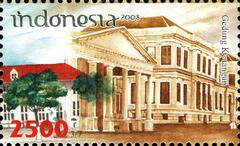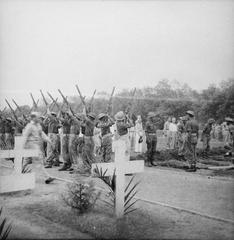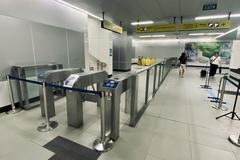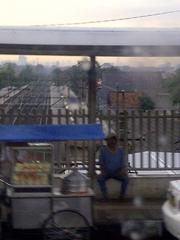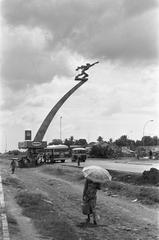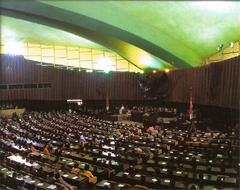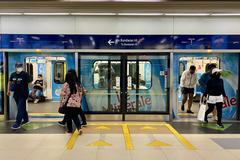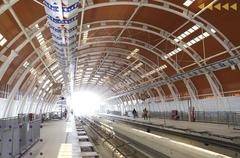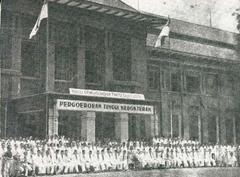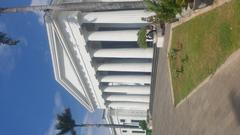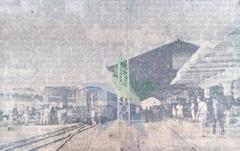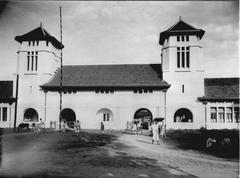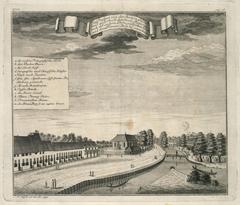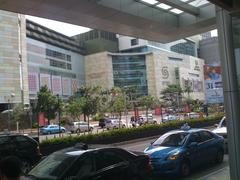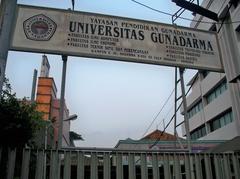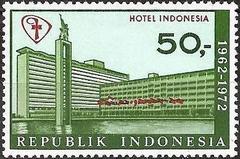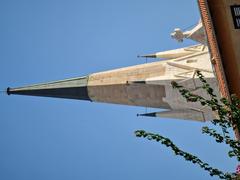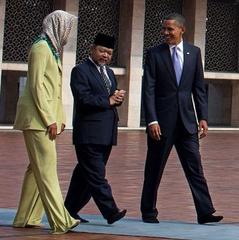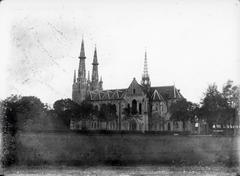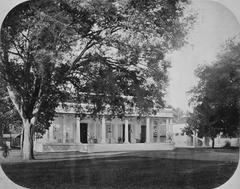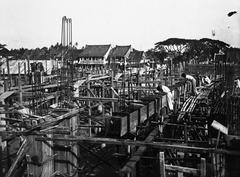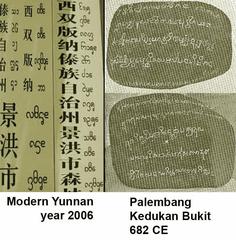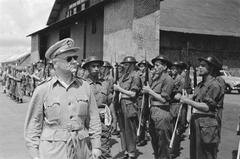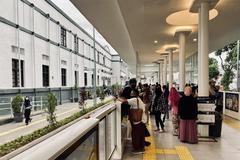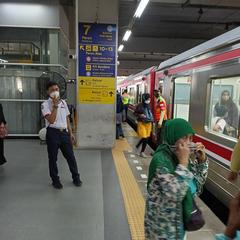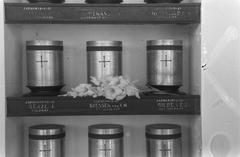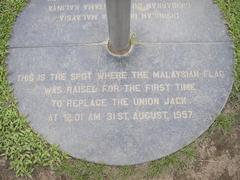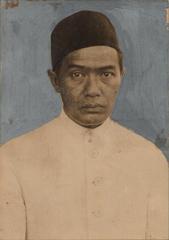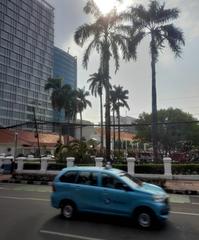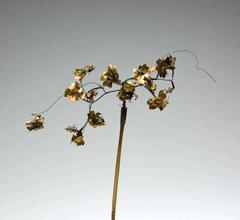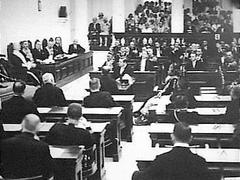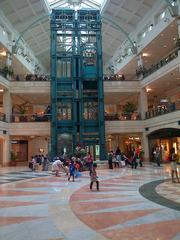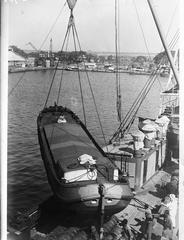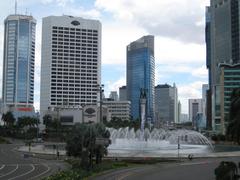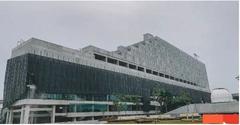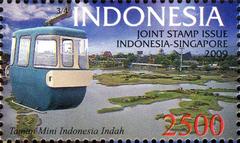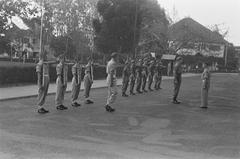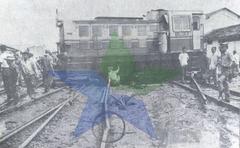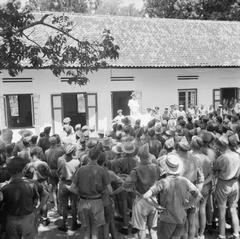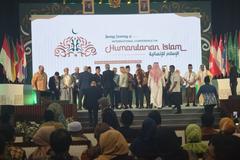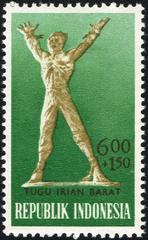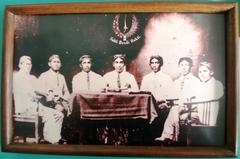Complete Guide to Lebak Bulus Stadium: Visiting Hours, Tickets, and Jakarta Historical Sites
Date: 04/07/2025
Introduction: The Legacy of Lebak Bulus Stadium
Lebak Bulus Stadium was once a vibrant landmark in South Jakarta, Indonesia, serving as a focal point for Indonesian football and urban community life. Officially opened in 1987, the stadium played host to legendary football matches, iconic concerts, and community gatherings, deeply influencing the city’s social and cultural fabric. Its demolition between 2014 and 2016 marked a significant shift in Jakarta’s urban development, making way for the Jakarta Mass Rapid Transit (MRT) depot and station—a testament to the city’s commitment to modern, sustainable infrastructure (Tempo; Jakarta MRT Official Website).
Although the stadium no longer stands, its spirit endures in the memories of football fans, especially The Jakmania, and the ongoing urban transformation of Jakarta. Today, the site is accessible via the Lebak Bulus Grab MRT Station, providing a tangible link between Jakarta’s storied past and its dynamic future (Academia.edu Feasibility Study; MRT Jakarta Guide).
Table of Contents
- Historical Background
- Football Legends and Iconic Matches
- Cultural and Social Significance
- Demolition and Urban Transformation
- Visiting Lebak Bulus Today
- Jakarta International Stadium and Modern Football
- Visitor Information
- Nearby Attractions and Travel Tips
- Visuals and Media
- Frequently Asked Questions (FAQ)
- Conclusion and Call to Action
- References and Further Reading
Historical Background
Origins and Construction
The Lebak Bulus area, originally a fertile lowland named for its abundance of freshwater turtles, supported Betawi communities and agricultural activities throughout colonial times. Infrastructure advancements in the post-independence era, including the establishment of Lebak Bulus Bus Terminal, set the stage for the stadium’s construction in 1987. Designed as a multi-purpose venue with a seating capacity of approximately 12,000–25,000, Lebak Bulus Stadium quickly became the home ground for clubs like Pelita Jaya and, later, Persija Jakarta (Tempo; Jakarta MRT Official Website).
The stadium’s stands, located close to the pitch and without an athletics track, created an intense and unforgettable match atmosphere.
Football Legends and Iconic Matches
Lebak Bulus was the site of historic football events, including Persija Jakarta’s championship run in 2001 and fierce rivalries with clubs like Persib Bandung. It was also the birthplace of The Jakmania, Persija’s passionate fanbase, founded at the stadium in 1997. The stadium hosted international competitions, such as the AFC U-17 Championship qualifiers and men’s football events during the 2011 SEA Games.
Beyond football, Lebak Bulus was a popular concert venue, welcoming global acts like Metallica and Sepultura, as well as Indonesian icons like Iwan Fals, cementing its place in Jakarta’s cultural memory (The Nusantara Bulletin; The Jakarta Post).
Cultural and Social Significance
The Jakmania and Community Spirit
The stadium’s atmosphere was powered by The Jakmania, whose chants and rituals fostered a strong sense of identity and belonging. Lebak Bulus was more than a venue—it was a hub for community gathering, local businesses, and a source of civic pride.
Political and Urban Identity
The demolition of Lebak Bulus became emblematic of Jakarta’s modernization challenges. The absence of a dedicated home for Persija Jakarta influenced political discourse, culminating in promises and eventual construction of the new Jakarta International Stadium (JIS) (Academia.edu Feasibility Study).
Demolition and Urban Transformation
Rationale and Process
The need for efficient, sustainable transportation in Jakarta led city planners to select the Lebak Bulus site for the MRT’s main depot (Berita Jakarta). Demolition began in 2014, overseen by Governor Basuki Tjahaja Purnama, and concluded by 2016. The process sparked debate among urbanists and football fans, who mourned the loss of a beloved landmark but recognized the necessity of improved public transit (Tempo; The Jakarta Post).
New Urban Function
Today, the former stadium functions as the main depot for the Jakarta MRT, a symbol of the city’s shift toward sustainable mobility and urban renewal (Jakarta MRT Guide).
Visiting Lebak Bulus Today
The Lebak Bulus Grab MRT Station
The stadium’s site is now home to the Lebak Bulus Grab MRT Station, a modern gateway to South Jakarta. While the stadium itself cannot be visited, the station is accessible daily from early morning until late evening and features commemorative plaques and local stories about the stadium’s legacy (Jakarta MRT Official Website).
- Location: Lebak Bulus, South Jakarta
- Access: Jakarta MRT (Lebak Bulus Grab Station), TransJakarta buses, taxis, and ride-hailing services
- Facilities: The station is fully accessible, with amenities for disabled visitors
- Tickets: No entry fee for the station; regular MRT tickets apply
Jakarta International Stadium and Modern Football
Persija Jakarta and The Jakmania’s new home is the Jakarta International Stadium (JIS) in North Jakarta, a state-of-the-art facility with a capacity of around 80,000 (Academia.edu Feasibility Study). JIS hosts domestic and international matches, concerts, and cultural events.
- Visiting JIS: Tickets for matches and events are available online or at the venue. Guided tours may be arranged through official channels.
- Access: Reachable via TransJakarta buses, taxis, and ride-hailing services.
Visitor Information
Alternative Sports Venues
If you’re interested in experiencing Jakarta’s sporting spirit, consider visiting:
- Gelora Bung Karno Stadium: The city’s primary large sports venue for football and athletics
- Community Sports Centers: Various facilities across Jakarta for local sporting events
Historical and Cultural Sites Nearby
- Setu Babakan: An area dedicated to Betawi culture and traditions
- Cilandak Cultural Center and Ragunan Zoo: Attractions near the former stadium site
- Pondok Labu Market, Kemang Area: Local shopping, food, and nightlife
Travel Tips
- Use the MRT or TransJakarta for convenient, affordable transport
- Check event schedules and ticket availability on official websites
- Download the Audiala app for updates on Jakarta’s events and cultural guides
Visuals and Media
Image suggestions:
- Archival photos of Lebak Bulus Stadium in its prime (Alt: “Lebak Bulus Stadium Jakarta historical match”)
- Demolition process (Alt: “Demolition of Lebak Bulus Stadium for MRT depot”)
- Current images of Lebak Bulus Grab MRT Station (Alt: “Lebak Bulus MRT Station today”)
- Jakarta International Stadium events (Alt: “Jakarta International Stadium football match”)
Interactive map: Visualizing the transition from stadium to MRT depot and its urban context.
Frequently Asked Questions (FAQ)
Q: Can I visit Lebak Bulus Stadium today?
A: No. The stadium was demolished; the site is now occupied by the Lebak Bulus Grab MRT Station (Tempo; The Jakarta Post).
Q: What replaced Lebak Bulus Stadium?
A: The Jakarta MRT main depot and station now occupy the site.
Q: Where can I watch Persija Jakarta matches?
A: At Jakarta International Stadium (JIS) in North Jakarta.
Q: How do I get to the former stadium site?
A: Take the Jakarta MRT to Lebak Bulus Grab Station. The station is modern, accessible, and well-connected.
Q: Are there alternative sports venues?
A: Yes. Gelora Bung Karno Stadium is the main alternative, alongside various community sports centers.
Q: What are some nearby cultural attractions?
A: Explore Setu Babakan, Cilandak Cultural Center, Ragunan Zoo, and Kemang’s vibrant scene.
Conclusion and Call to Action
Lebak Bulus Stadium’s legacy is a powerful reminder of how sports, culture, and urban development intersect in Jakarta. Its transformation into a modern MRT hub underscores the city’s commitment to progress while evoking nostalgia for a beloved communal space. Football fans, history enthusiasts, and travelers can explore this evolution by visiting the MRT station, attending matches at Jakarta International Stadium, or discovering the city’s diverse cultural sites.
Stay updated on Jakarta’s sporting and urban developments by downloading the Audiala app and following official social media channels. Embrace Jakarta’s dynamic blend of tradition and innovation—where every visit connects you to the city’s rich past and ambitious future.
References and Further Reading
- Lebak Bulus Stadium Jakarta: History, Visiting Hours, and Legacy, 2025, Jakarta MRT Official Website
- 20 Extraordinary Facts About Lebak Bulus Stadium, 2025, BARK
- Exploring Lebak Bulus Stadium: Visiting Hours, Tickets, and Its Role in Jakarta’s Football and Urban Culture, 2025, Ekaputrawisata
- Integrated Feasibility Studies: A Tool for Sustainable Development for Jakarta International Stadium, 2021, Academia.edu
- Lebak Bulus Stadium Demolition and Jakarta’s Urban Transformation: Visitor Guide and History, 2025, Berita Jakarta
- Heavy Metal in Indonesia: Challenging Societal Norms, 2019, The Nusantara Bulletin
- View Point: The Sad End of a Stadium, 2015, The Jakarta Post
- Jakarta MRT Guide, 2025, Backindo
- Audiala App: Jakarta Travel and Cultural Guide, 2025
